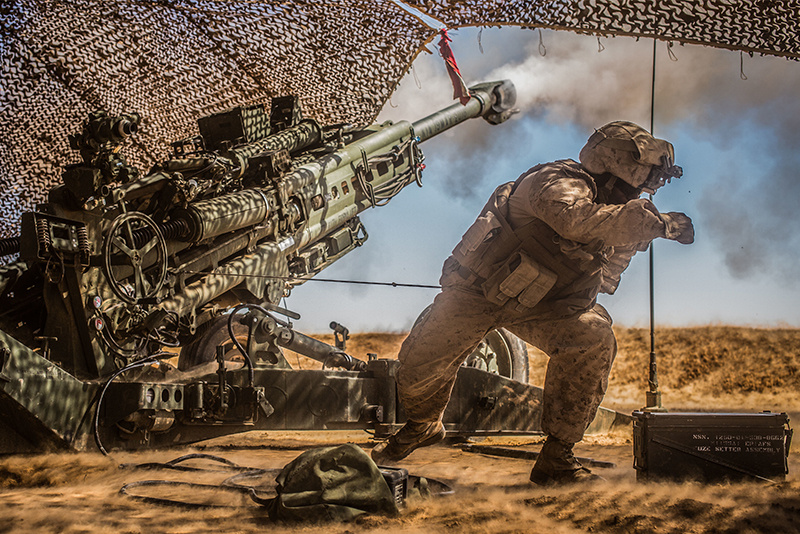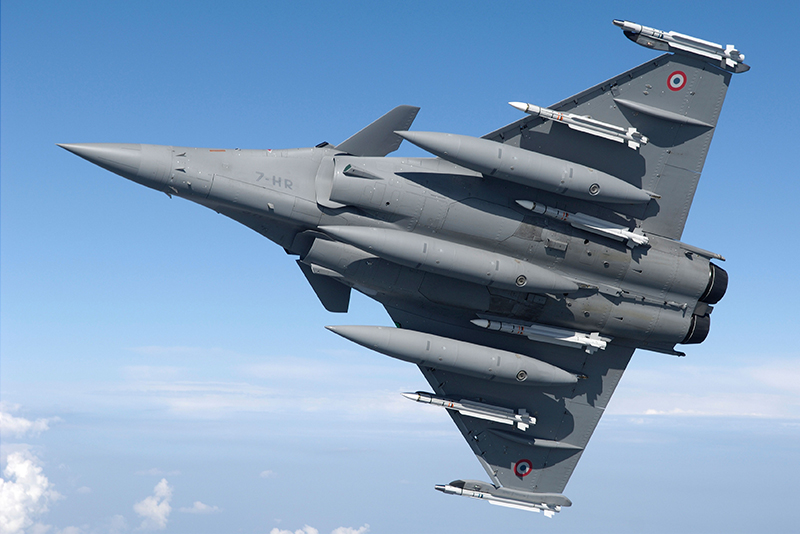
Debalina Ghoshal – In 2018, Defence Minister Nirmala Sitharaman caused concern among many analysts and policy makers when she stated that India had ammunition that could last for ten days if a war broke out. Since then, reports indicate that Sitharaman’s target is to stockpile enough ammunition that would enable India to fight for forty days or more.
Existing doctrine states that the Indian Army must be prepared to fight a two-front war and for this there is a need for more sophisticated weapon systems. However, the government’s procurement policy is not good and it has been mired in controversies and bureaucratic delays. All the three of India’s armed forces require modern weapons to strengthen both their conventional and nuclear deterrence capability.
The Indian Army
India’s obsolete assault rifle is a concern especially as the Indian Army is not only challenged to fight against potential adversaries such as Pakistan and China, but it is also involved in frequent low intensity conflicts. The Indian Army relies mainly on its assault rifles for counter terrorism operations and still retains the INSAS 5.56x45mm rifle, while its adversaries have been well equipped with Kalashnikov 7.62mm. The Defence Ministry has already approved of a budget of $255 million (INR1,798 crores) for the purchase of 72,400 advanced assault rifles. In August 2018, it was reported that the Army put forward a Request for Information (RfI) to the Ordnance factory Board (OFB) for a 7.62x51mm calibre rifle with an effective range of 300 metres for a ‘shoot to kill’ capability.
The Army is also in need of close-quarter battle carbines as well as light machine guns. India plans to manufacture under license the Russian AK-103 7.62x39mm under its ‘Make in India’ policy. In 2018, an RfI was reportedly made to US manufacturer Sig Sauer for the company’s SiG 716 7.62mm rifle as well as to UAE weapons firm Caracal for its CAR 816 close quarter carbine. While the rifles would replace the existing INSAS rifles, the carbines are expected to replace the current 9mm Sterling Carbines.
The Defence Ministry is also expected to consider a $284m (INR2000 crore) proposal on to acquire 17,000 light machine guns (LMGs) and 6500 sniper rifles to replace the Russian Dragunov rifles currently in service.
The Kargil conflict with Pakistan in the summer of 1999, in which artillery proved its mettle became an eye opener for the Army that necessitated the need to modernise the artillery force. Following the Bofors scandal in the late 1980s over the supply of 155mm howitzers, the Indian Army has not acquired any more of this type of artillery. However, the Defence Research and Development Organisation (DRDO) has now developed and tested its own Advanced Towed Artillery Gun System (ATAGS) 155mmx45mm calibre Dhanush artillery (based on the Bofors Haubits FH77) which is now ready for induction with the Army. The howitzer has undergone trials under severe conditions that include the cold and rough weather in the mountains as well as in the deserts. The gun has a range of 31kms and it is expected that a total of 414 guns will be supplied to the Army.
In November 2018, the Army received its first batch of the BAE Systems’ Global Combat Systems M777 ultra-light howitzers from the United States, and also the K-9 VAJRA-T 155mm/52mm calibre tracked self-propelled howitzer from South Korea, which includes a Composite Gun Tractor to tow the guns.

In May 2018, India conducted successful testing of the guided version of the Pinaka multi barrel rocket launcher (MBRL) which was developed by the DRDO. It has a range of 40kms but this can be extended to 70kms.
The Army’s air defence also needs a revamp and in November 2018 and it is expected that Russia will supply its Very Short Range Air Defence (V-SHORAD) system, the KB Mashinostroyeniya (KBM) Igla-S system to replace the existing the Igla-M systems. By 2020, the Army is expected to receive the advanced medium range surface to air (MR-SAM) missile and would be a joint production between the DRDO and Israel Aerospace Industries (IAI).
In July 2018, the Ministry of Defence also cleared a $340m (INR2400 crore) proposal to upgrade India’s armoured forces and make them capable of undertaking night operations. The Army is in need of 2,500 armoured fighting and command post vehicles and the Ordnance Factory is looking into this need. The Army will potentially upgrade its T-90 tanks with third generation missiles allowing a range of 8kms to replace the laser guided INVAR missile. The T-90 may also be upgraded with a new modular engine. The development of the Future Ready Combat Vehicles (FRCV) programme remains an aspiration but faces uncertainty due to differing visions of what will be required.
India’s anti-tank missile arsenal also needs a revamp. Although the arrival of the new ‘fire and forget’ Nag missile will be a relief for the Army, it is yet to acquire the Spike anti-tank missile from Israel as further tests in 2019 have been requested. India has already opted for the Spike missile over the Raytheon/Lockheed Martin FGM-148 Javelin.
As regards mechanised forces, India needs to replace the Soviet era BMP-2 infantry combat vehicle (ICV) for which there is a plan to move ahead with the project Future Infantry Combat Vehicle (FICV).
Indian Air Force (IAF)
In July 2018, the IAF came out with its ten year modernisation plans that would identify technologies and services necessary to improve the conventional and nuclear deterrence of the IAF. These include not only main weapon systems but also their subsystems such as those for its SEPECAT Jaguar fighter aircraft as well as parts and spares of the An 32 transport fleet. The plan also includes Maintenance, Repair and Overhaul (MRO) of existing systems creating room for private sector participation. In July 2018, there were reports that the IAF had launched a new drive to revamp its 118 Jaguar ground attack aircraft with new avionics, communications, active electronic array radars and airborne weapon systems.
The Mirage 2000 fighter aircraft is being upgraded with Indian made multi-function displays in order to increase its operational role as a multi-role fighter. The MiG 29 combat aircraft are also undergoing modernisation that will increase the flying time of the aircraft through air-to-air refuelling, as well as improving the head-up display and helmet monitoring system.
There continues to be a shortfall in transport and and other helicopter fleets that needs to be addressed. The Chetak and Cheetah helicopters have been obsolete for a long time and need replacement and the indigenously developed Light Utility Helicopter is expected to replace the obsolete helicopters, although this is taking considerable time and is long overdue. The medium lift helicopters like the Russian Helicopters Mi-8 and Mi-26 are also obsolete and need replacement. According to reports, Hindustan Aeronautics Limited (HAL) is set to develop a medium multi role helicopter. HAL has asked for an RfI from French Safran Helicopter Engines that is developing a high power engine called the Aneto for possible acquisition. India is also expected to receive the Apache AH-64E multi-role combat helicopters and CH-47 Chinook tactical transport helicopter.
The IAF is soon to get the BrahMos air launched cruise missile and in July 2018 the missile undertook successful air tests from the Sukhoi-30MKI. India is also working on a hypersonic version of the BrahMos missile that would use air breathing technology.
In order to strengthen its air defence capability, there is a plan to buy the Russian S-400 air and missile defence system which is claimed to be one of the most sophisticated of its type in the world. In January 2018, there was also report that India was planning to replace the obsolete Russian L-70 and ZU-23-2B air defence systems with new generation close-in weapon systems under a $1.5billion programme that would also include air defence guns, fire control and search radars and programmable ammunition. In July 2018, the IAF also planned to acquire single engine aircraft to enhance its overall strike capability and looks set to go ahead with a joint production with a foreign company for which RfI is expected to be issued.
As regards combat aircraft, by 2019 India has also planned to acquire the French Dassault Rafale combat aircraft although this acquisition has yet again been plagued by controversy. Delivery and testing of the aircraft is expected to be completed by April 2022 as long as the deal goes ahead. In July 2018, reports came in that India was to acquire missile armed drones from Israel-company IAI called the Heron TP. It will offer the capability to detect, track and take down targets with missiles. An indigenous drone program called the Rustom is also being pursued by the DRDO.

Indian Navy (IN)
The Indian Navy is also modernising its forces to move towards blue water capability. As China’s Navy continues to modernise, India has to follow suit. The IN is working on the Indigenised Aircraft Carrier (IAC) and is expected to be inducted into the Navy in 2020. In July 2018, there were also reports that that India is set to develop six nuclear powered attack submarines to enhance its sea-based deterrence. Some existing submarines will be upgraded under ‘Major Refit and Life Certification’. These include INS Sindhukesari, INS Sindhuraj, INS Sindhughosh, INS Shishumar and INS Shankush. The IN will also induct the INS Arihant SSBN into its naval fleet. Sea trials of INS Aridhaman will begin in 2019 after which it will be inducted into the Navy.
The IN is also conducting ongoing trials of the Deep Submergence Rescue Vehicle (DSRV) that would be able to rescue at least fourteen personnel at a given time from a disabled submarine.
As regards defence by denial weapons, India’s Bharat Electronics Limited (BEL) and IAI have entered into joint agreement to supply the IN with the long range surface-to-air missile (LR-SAM). The system has been jointly developed by the IAI and the DRDO. The indigenously developed Varunastra torpedoes in 2018 could be supplemented if the IN selects the German SUT torpedoes for its Kalvari class submarines. India’s Defence Acquisition Council has approved a programme to procure 127mm calibre guns for the Navy from the BAE systems. The gun will have an engagement range of 24km which can be extended through the use of extended range munitions. There is also a decision to acquire Sikorsky/Lockheed Martin MH-60R helicopters from the United States. These helicopters would be used as anti-submarine (ASW) helicopters and would replace the decades old Sea King helicopters. In November 2018, India also inked a deal with Russia for the design and transfer of technology for the construction of two guided missile stealth frigates. India may also acquire the GA-ASI Predator B Sea Guardian from the United States for maritime reconnaissance. Variants for the Air Force and Army may also be acquired. The IN is also set to receive additional P8-I long range maritime reconnaissance aircraft. Due to a Transfer of Technology agreement, India will be able to equip the aircraft with its own components like the Data Link II system that would enable the aircraft to facilitate communication with Indian space-base and naval assets.
Radar
The Electronics and Radar Development Establishment is the laboratory of the DRDO responsible for the development of radars. The establishment partners with Bharat Electronics Limited and some private partners like Astra micro and Data patterns for radar development and production. These radars are INDRA (Indian Doppler radar), Rajendra Radar for Akash surface-to-air missiles, Central Acquisition Radars- both Rohini (army variant) and Revathi (Air Force variant), Swathi weapons locating radar, Ashwini radar, Arudhra radar, and PJT-31 Battlefield Surveillance Radar.
Conclusion
India’s military modernisation is progressing despite the serious delays and political indecision that impacts on so many projects. As India faces threats from not just state actors but also non-state actors including terrorist groups, its modernisation process must be greatly improved.












